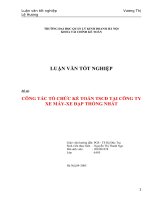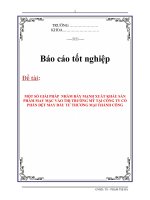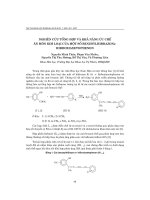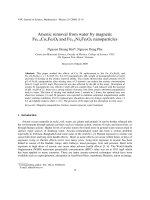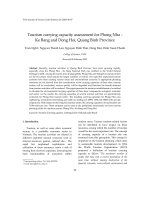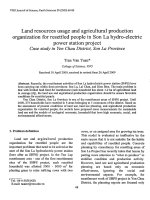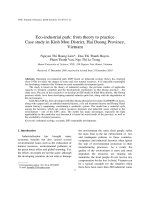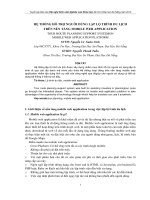Tài liệu Báo cáo " Eco-industrial park: from theory to practice Case study in Kinh Mon District, Hai Duong Province, Vietnam " doc
Bạn đang xem bản rút gọn của tài liệu. Xem và tải ngay bản đầy đủ của tài liệu tại đây (189.66 KB, 12 trang )
VNU Journal of Science, Earth Sciences 27 (2011) 1-12
1
Eco-industrial park: from theory to practice
Case study in Kinh Mon District, Hai Duong Province,
Vietnam
Nguyen Thi Hoang Lien*, Dao Thi Thanh Huyen,
Pham Thanh Van, Ngo Thi Le Trang
Hanoi University of Science, VNU, 334 Nguyen Trai, Hanoi, Vietnam
Received 17 December 2010; received in revised form 31 December 2010
Abstract. Operating eco-industrial park (EIP) based on industrial ecology theory has emerged
since 1970s to reduce the impact of waste and save natural resources. It is especially meaningful
for developing countries like Vietnam to reach sustainable development goals.
The study is based on the theory of industrial ecology, the previous studies of applicable
capacity in Vietnam condition and the development orientations in Hai Duong province – the
study area. The aim of this research is to develop an EIP model in Kinh Mon district, Hai Duong
province which have been developing material industry quite fast, along with the degradation of
the environment.
Kinh Mon EIP has been developed with Hai Duong thermal power plant (2x600MW) in focus,
along with a paper mill, an unbaked material factory, a fly ash treatment factory and Hoang Thach
cement factory’s supporting; constituting a symbiotic system. The model has a material cycle
among the factories, which can reduce resources demands and industrial waste emitted to the
environment – one of the EIP's aims. The model has many advantages, especially the high
applicability in this particular case because it is based on actual needs of the province, as well as
the availability of natural resources.
Keywords: industrial ecology; eco-park; EIP; sustainable development.
1. Introduction
∗
Industrialization has brought many
economic benefits but also caused several
environmental issues such as the exhaustion of
natural resources, environmental pollution or
the green house effect and global warming. Yet,
the effects on people are not the same; although
the developing countries do not emit or damage
_______
∗
Corresponding author. Tel.: 84-4-38584995
E-mail:
the environment the most, their people suffer
the most. Due to the lax enforcement of law
and inadequate policies in those countries,
companies and industrial factories often ignore
the step of environmental protection in their
manufacturing processes. As a result, the
quality of the environment is more and more
degraded, the resources are running out,
meantime, the local people do not receive any
compensation for the lost. In brief, Vietnam can
be a typical example for the situation when
there have been more than 200 industrial zones
N.T.H. Lien et al. / VNU Journal of Science, Earth Sciences 27 (2011) 1-12
2
established at the end of 2008 with a lot of
environmental problems occurring in this
developing country.
One of the solutions for that problem that
had been implemented all over the world is the
reconstructing those normal industrial zones
into eco-industrial parks first known in the case
of Kalundborg, Sweden in the 1970s [1]. The
theory underneath this model is industrial
ecology, of which the idea is reusing residue of
one factory in the other within the same
industrial zone, so they can save ingredients as
well as use energy efficiently and protect the
environment. In details, industrial ecology helps
minimize the use of natural resources and the
impacts of development on natural systems.
The term ‘eco-industrial park’ (EIP) has
emerged from the theory of industrial ecology.
EIP has been developed strongly in many
developed countries and very limited in
developing countries including Vietnam.
The study area, Kinh Mon district, is
located in Hai Duong province, a province in
the Red River delta, Northern Vietnam with a
total area of 112.9 km
2
[2]. Kinh Mon district is
surrounded by Da Vach river in the North, Kinh
Thay river in the West and the Han river in the
East. The main characteristic of terrain in this
area is medium mountainous, interspersing by
plain.
The study area is in the tropical monsoon
climate. A year has four distinct seasons.
Winter is cold, summer is hot and wet, spring
and autumn are transition periods. Average
temperature is 22.4
o
C, average rainfall varies
from 1,500 to 1,700 mm, and average annual
sunshine is 1,700 hours, facilitate the tropical
and sub-tropical plant [2].
The population of Kinh Mon district is over
120 thousand people with a population density
of 1,100 persons/km
2
[2]. Kinh Mon district
comprises 22 communes and three towns (Minh
Tan, Phu Thu, Kinh Mon) (as shown in Figure 1).
Figure 1. Kinh Mon district administrative map (Source: Atlas of Vietnam, Ministry of Science,
Technology and Environment, 1997).
N.T.H. Lien et al. / VNU Journal of Science, Earth Sciences 27 (2011) 1-12
3
In the past, agricultural production
dominated Kinh Mon’s economic structure;
however, in recent years, local people have
experienced much significant industrial
development and several severe environmental
impacts, in addition. Clean production, green
industry and sustainable development are the
goals that this district would like to achieve.
Building an EIP for this area is one of the
measures to help achieving these goals. The aim
of this research is to apply the theory of
ecological industry and criteria of EIP to
develop an EIP for Kinh Mon district. The
result of this research is not limited to be used
for that district but also can be applied to other
case elsewhere.
2. Materials and methodology
2.1. Materials
Collected data includes Strategy for Socio-
economic Development of Hai Duong province
and Kinh Mon district until 2015 [3]; Calling
for Project Investment by provincial
government [2]; and the State of Environment
Report (SoER) of Hai Duong province in 2009
[4]. In addition, several maps were collected
and are important documents for analysis.
2.2. Eco-Industrial Park theory
Many environmental problems from
industrial zone so far are attributed to the
irferiority in metabolism process in comparison
with a natural eco-system. A natural ecosystem
has the great advantage of closing the material
cycle. As a universal ecological knowledge,
each active system has composed of three parts:
production group, consumption group and
decomposition group. The higher quantity of
waste a system could renew, the more complete
it becomes. Unlike a natural ecosystem, the
decomposition group in an industrial system
cannot fulfill the task of recovering and
recycling material. Thus the industrial system is
not closed, and the matter often leaks into the
environment uncontrollably.
- In order to eliminate this limitation,
scientists had tried to applied the advantage of
natural ecosystem to the industrial system –
transform into an industrial ecosystem -
changing the current one into a system with
natural ecological functions such as closed
material, energy cycles, recycling materials,
waste and so on. This is known as Industrial
Ecology theory, the basic theory beneath an
Eco-industrial park [5]. The word ‘industrial’
does not only mean manufacturing industries
but also the services and construction processes
involved.
The most popular application of Industrial
Ecology theory is eco-industrial park (EIP).
According to Ernest A. Lowe (2001), an EIP or
estate is defined as a community of
manufacturing and service businesses which is
located together on a common property.
Member businesses collaborate in resolving
environmental and resource issues such as
wastes, pollutions, energy-saving and resources
demand. By working together, the collective
benefit can be greater than the sum of
individual benefit gained by each company by
only optimizing its performance. The goal of an
EIP is to improve the economic performance of
the participating companies along with
minimizing their environmental impacts.
Components of this approach include green
design of park infrastructure and plants (new or
retrofitted); cleaner production, pollution
treatment; energy efficiency; and inter-company
partnering. An EIP also seeks benefits for local
communities to assure that the entire impact of
its development is positive.
N.T.H. Lien et al. / VNU Journal of Science, Earth Sciences 27 (2011) 1-12
4
So far, there is no official standard for an
eco-industrial park. According Ernest A. Lowe
(2001), to be a real eco-industrial park, an
industrial zone/area must be more than:
§ A single by-product exchange or network
of exchanges;
§ A recycling business cluster;
§ A collection of environmental technology
companies;
§ A collection of companies making
“green” products;
§ An industrial park designed around a
single environmental theme (i.e., a solar
energy driven park);
§ A park with environmentally friendly
infrastructure or construction; or
§ A mixed-use development (industrial,
commercial, and residential).
2.3. Review of previous study on building EIP
model
Developed countries have attained great
achievements when applying EIP. One of the
most successful is Kalundborg EIP which was
developed during the latter half of 20th century [6].
This EIP is power-plant-based type, which has
an Asnæs thermal power plant (1,500 MW) in
the center. A by-product exchange system has
been created there. Water cycle in EIP is based
on the supply of Fjord Sea and Tissø Lake.
About 40% - 60% of energy is redundant and
emitted into the environment. To enhance
economic benefits, that waste energy is
transferring to Statoil refineries, Novo Nordisk
pharmaceutical and enzyme plant and farms as
well as for warming Asnaes Kalundborg city
(about 20,000 people) in winter. Other wastes
from power plant such as gypsum is reused in
Gyproc plaster walls plant, ash and slag in
Aalborg cement and paving materials factory,
etc. Kalundborg industrial zone has been
considered first eco-industrial park in the
world.
The second example is an Agro-Industrial
Eco-complex named Seshasayee – India [1]. In
this case, the structure is much simpler, with a
paper mill, a sugar mill and an alcohol plants.
Paper mill was the first factory of the system.
Then, to meet the demand of raw materials, a
sugar factory was established. Waste from
sugar cane production (bagasse) is used as raw
materials for paper production, and molasses (a
byproduct from sugar production) is used to
manufacture ethanol alcohol. To ensure an
abundant supply of sugarcane, the
manufacturers strengthen the relationship with
farmers, such as making agreement on buying
back the products or ensuring irrigation water
supply. Other eco-friendly actions of this
complex are reusing treated waste water and the
paper bagasse as an energy source.
2.4. Method
A number of issues should be noted when
apply EIP model in case of Vietnam such as:
- Eco-industrial model of the developed
countries can not be applied directly to Vietnam
due to differences in technical, economical and
social conditions.
- The proposed EIP model should be feasible
to be applied to the existing industrial zone with
many different types in Vietnam so far.
- It is necessary to consider not only
technology and characteristic of each sector to
optimize the material flow, but also the role of
related institutions and agencies in order to put
the theoretical model into practice.
In Vietnam current condition, with
limitations in manufacturers' awareness, finance
and technology, the application which prioritizes
N.T.H. Lien et al. / VNU Journal of Science, Earth Sciences 27 (2011) 1-12
5
pollution preventing would be less practical.
Instead, the priority order below should be
considered as a temporary solution: (1)
recycling and reusing of wastes, (2) end-of-pipe
treatment, and (3) gradually shift towards
preventing and minimizing waste at source once
the manufacturers' awareness in environmental
issues as well as the technology have improved.
Using data in Hai Duong thermal power
plant's technical document, the study firstly
calculated the amount of waste emitting when
the factory is operating. The calculation
involved the amount of water used, lost water
(i.e. vaporizing); amount of coal used, ash and
cinder, excessive heat and energy that can be
used in other manufactories. The study also
assessed the supplying capacity of mines in and
around the project area.
Furthermore, the location of certain
factories in the projected area have been
identified based on the analysed information
regarding the local demands (i.e. Hai Duong
thermal factory project area). Therefore, a chain
of plants and factories, which use waste and by-
products from each one in its own manufacture,
has been built, in order to reduce waste and the
resources demand.
Next, the amount of resources demand (i.e.
water and energy) and waste were accounted
for, in order to find out the best way to reuse
and recycle them in other factories. Thus, the
expected capacity was set for each factory due
to the calculation above so that each member
can get most benefit from the others. As a
result, the chain has been closed with a
material-energy cycle.
3. Result
Basing on the data calculation above, a
model constitution of five factories has been
built of which operation diagram is shown as in
Figure 33. The location of this eco-industrial
park is shown in 2. Details of each factory in
our EIP model with approximate expected
capacity and area are described below.
3.1. Hai Duong thermal power plant
- Location: Phuc Thanh commune, Kinh
Mon district, Hai Duong province
- Planned square: 82.86 ha
- Designed capacity: 2x600 MW; including
two units: each unit has one turbine and two
circulating fluidized bed boilers.
- Input:
§ Fuel: Major by 6B bran coal exploited
from nearby mines (Quang Ninh and Hai
Duong provinces) with total amount of
4,239,300 tons.yr
-1
and minor by fuel oil
FO 2BDesulphurized agent: limestone;
234,000 tons used each year.
§ Water supply: Source: Kinh Thay river;
closed circulation; almost used for
cooling and boiler purposes. Total
amount: 480m
3
.hr
-1
.
N.T.H. Lien et al. / VNU Journal of Science, Earth Sciences 27 (2011) 1-12
6
Figure 2. Location of Kinh Mon eco-industrial park.
Figure 3. General diagram of Kinh Mon eco-industrial park.
N.T.H. Lien et al. / VNU Journal of Science, Earth Sciences 27 (2011) 1-12
7
Details of water demand are presented in Table 1.
Table 1. Details of water demand of Hai Duong thermal power plant [7]
No Water demand Raw water Filled water Demineralized water
1 Additional water for steam cycle (max 3%) 145.6 330 122.8
2 Additional water for closed cooling cycle 28.4 25.6 24
3 Additional water for central conditioning station 47.6 42.4 40
4 Other purpose 22.4 20
5 Cleaning tools in coal warehouse 56
6 Spraying for dust control in coal warehouse 40
7 Reverting water for cleaning demineralized vessel 14.4 12.8 12
8 Domestic water 80.4 72
Total 434.8 302.8 198.8
Provision (10%) 43.6
Due to the high quality requirements, water
must be treated through a two-step system:
general treatment and then demineralization.
- Output:
§ Cinder and ash: total amount of
1,899,560 tons.yr
-1
, detail:
• Cinder: from burning coal in
combustion chamber, almost fall
down to containing funnel in the
bottom.
• Ash: also emitted from coal
burning, ash is the small, light one
escaping through chimney, of
which almost is later trapped in dust
removing equipment and the little
amount remaining is released to the
environment.
§ Waste from limestone used in coal
desulphurization.
§ Excessive heat: according to the
technical document, the useful heat rate
that will convert into electricity later is
only 38.15% and the remaining is partly
waste escaping through exothermic
process of boiler as well as other
equipments, other part is emitted
indirectly by this process happening in
condenser. Besides, there is also an
amount of heat radiating to the
environment from cooling activities.
§ Gases emission, including:
• Emission from coal fired boiler:
SO
2
, NOx, CO and VOCs
• Emission from vehicle such as: coal
dust, SO
2
, NOx, CO
2
, VOC, Pb
• VOCs leakage from pouring,
loading, exporting, transporting fuel
or from gases tank.
§ Waste water: total amount of 400m
3
.hr
-1
,
often contains one or more pollutants
that are acidic, alkaline; suspended
solid; malnutrition with redundant of
antibiotics N, P; high COD; as well as
dust oil, heavy metals, and bacteria
(Coliform).
Waste water will be treated following
regulations mentioned in National standard
5945-2005 and then released to the cooling
channel and finally to the environment.
3.2. Unbaked material factory
Products of factory are bricks and roof tiles,
commonly used for construction. They are
made of various materials through different
technologies.
N.T.H. Lien et al. / VNU Journal of Science, Earth Sciences 27 (2011) 1-12
8
Raw materials used in production include
cement, sand, gravel, coal slag, etc Unbaked
material has many advantages compared to
traditional one such as saving resources,
avoiding coal so not polluting the air, bearing
high-pressure as well as taking benefits from
waste
Specific proposal of unbaked materials
plant in Kinh Mon EIP as follows:
- Expected area: 2 ha
- Input material: Depending on the each
recipe, the amount of coal ash in unbaked
bricks varies from 30-60%, the remaining (ore
slag, solid waste, rock and cement powder)
accounts for 8-10% the whole
ingredient. Depending on the source of coal
slag, ore slag available, a suitable blending
recipe should be applied for highest economical
benefit.
3.3. Kinh Mon wrapping plant
Scale:
- Location: Phuc Thanh commune, Kinh
Mon district, Hai Duong province
- Expected area: 10 ha.
- Main product: wrapping paper.
- Capacity: 15,000 tons.yr
-1
;
Inputs:
- Recyclable paper: 34,500 tons.yr
-1
- Additives:
§ Pine resin (glue): (C
19
H
29
COOH):
6 kg.ton
-1
products.
§ Starch: 0.1 - 0.2 kg.ton
-1
of product.
§ Aluminum sulfate Al
2
(SO
4
)
3
.18H
2
O: 34
kg/ton paper product.
- Energy requirement: about 21,780,000
kWh.yr
-1
, 72,600 kWh.day
-1
, used for
production and lighting. All types of machinery
and electric equipment will use electricity from
Hai Duong thermal power plant, while
excessive heat from thermal power plant is
reused for drying paper.
- Water input: 10,000m
3
.day
-1
Output:
- Wrapping paper: 15,000 ton.yr
-1
;
supplying wrappings for Hoang Thach cement
factory and the others in this area.
- Water for cooling and washing machines:
30,000m
3
.day
-1
: Getting into the treatment
system before being transferred to Hai Duong
thermal power plants.
- Plastics and residues: 1 kg.ton
-1
of product.
3.4. Fly ash and cinder processing factory
Fly ash and cinder from Hai Duong thermal
power plant once be recycled and reused will
give much economic and environmental
benefits by cycling waste or saving land for
disposing waste.
- Location: Phuc Thanh, Kinh Mon district,
Hai Duong province
- Expected area: 5 ha
- Expected capacity: about 2,000,000 tons
of cinder and ash per year.
- Input material: fly ash and cinder from Hai
Duong thermal power plant and Hoang Thach
cement plant.
- Technique: use of rapid self-settled
technology to enhance sedimentation rate (the
technology which be used successfully in fly
ash processing factory, Pha Lai, Chi Linh, Hai
Duong). After treatments, the output of this
factory will be high-quality material for the two
others in Kinh Mon EIP: fly ash for Hoang
Thach cement factory and cinder for unbaked
material factory. This Fly ash and cinder treated
factory could be considered an intermediate
factory in the whole chain.
N.T.H. Lien et al. / VNU Journal of Science, Earth Sciences 27 (2011) 1-12
9
Figure 4. Diagram of Energy flow.
Figure 5. Diagram of water flow.
N.T.H. Lien et al. / VNU Journal of Science, Earth Sciences 27 (2011) 1-12
10
Figure 6. Diagram of material cycle.
4. Discussions and Recommendations
4.1. Discussion of Findings
Implementing an EIP brings not only
economic but also environmental benefit.
Unfortunately, there are a number of risks
which hamper the realization of an EIP. Below
is some main points of it pros and cons.
4.1.1. Benefits
For member businesses, performing an EIP
could not only reduce costs by saving material
and energy, sharing cost for services viz. waste
management, personnel training, supply and
environmental information systems, but also
increase production efficiency through a by-
product exchange mechanism. Particularly,
cement manufacture process requires gypsum
as an additive at about 2 million tons per year.
Domestic natural gypsum is not available, so
the supply of this mineral totally depends on
import source. Meanwhile, the SO
2
treatment
process in Hai Duong power plant produces
artificial gypsum which can be used in Hoang
Thach cement factory. This combination is a
great idea to solve both economic and
environmental issues: it can not only reduce
cost for additive but also reduce pollution and
resource demand.
N.T.H. Lien et al. / VNU Journal of Science, Earth Sciences 27 (2011) 1-12
11
In addition, EIP could also improve local
economic because its development could create
more employment opportunities and support the
development of local small industries and
traditional handicraft. For the environment
quality, performing EIP could reduce the
sources of pollution to the environment, waste
and resource demand through cleaner
production, reusing and recycling.
4.1.2. Challenges
Developing an EIP is a complex task,
requiring cooperation between the
communities, planners, contractors, and
enterprises in the industrial zone. This will be a
huge risk if the relationship between these
groups is not strengthened. Since EIP
development depends on collaboration,
interaction, interdependence of enterprises, it
may be difficult to ensure the quantity and
quality of supply of inputs; collecting waste
data and predicting the development becomes
more difficult. In particular, enterprises using
by-product or waste of each other as inputs are
also facing the risk of losing an important
market or supply if any plant is closed, even the
whole system may be collapsed. The problem is
especially serious in Vietnam where the link
among industrial branches is not tight.
On the one hand, developing an EIP may
require extra costs than the traditional industrial
zone, which may arise from the design process,
site preparation, infrastructure, construction,
and so on to ensure the proper functioning
according to the criteria of an EIP. On the other
hand, profit from it is only clear to see in long-
term, so the payback time may be longer. That
makes financial risk more ominous for the
investors, especially in a developing country
like Vietnam.
4.2. Recommendations
Becoming an industrial country and
making sustainable development reality are the
goals of every developing country, including
Vietnam. To achieve both of these targets, one
way is building an industrial production model
concerning an eco-friendly industrial facilities
and high scientific intellectual involvement.
This study presented here has proposed an
EIP model, which is basically involving the
industrial metabolism process, aims to
minimize the amount of waste emitted to the
environment, together with maximize the
economic benefits. The model based on the
theory of industrial ecology has many
advantages and is highly practical because it
also takes into account the industrial
development’s orientation in Hai Duong
province as well as all facilities, infrastructure
and resources raw material available there.
In order to enhance the feasibility of the
project, following recommendations have been
made:
For Hai Duong province
- Adjusting the projects (i.e. the project of
unbaked material factory, the wrapping paper
factory) by locating them in the Kinh Mon EIP
to reuse by-products and save resources.
- For future industrial projects, considering
the possibility of merging them into industrial
park, creating an efficient material cycle.
- Giving priorities (i.e. simplifying
administrative procedures, reducing tax, etc.) to
businesses involved in formulating and
developing eco-industrial parks.
- Establishing a multi-objectives
communication program for local people
raising awareness as well as supporting the
project.
N.T.H. Lien et al. / VNU Journal of Science, Earth Sciences 27 (2011) 1-12
12
For businesses
- Performing deeper research in technical
processes to minimize resources using, utilize
and cycle the material.
- Tightening the relationship between
enterprises in the industrial park to use
byproducts of each other.
For environmental scientists and other relevant
stakeholders
- Contributing experts' opinion for
completing EIP performance in order to operate
properly functions of an ecological industrial
park.
Conclusions
The study has reviewed EIP theory and
applied it to develop an EIP model for Kinh
Mon industrial area in Hai Duong province.
This is the first initiative of applying EIP theory
into practice in Vietnam. This model can help
to provide several economic, social and
environmental benefits for the communities
which in turn, can contribute to promote
sustainable development in the research area.
In further researches, it is intended to make
study on the benefits of the Kinh Mon EIP for
local communities; moreover, developing the
more completed models, taking more
advantages from waste byproducts, industrial
zones and implementing thoroughly waste
treatment by adding some other factories
according to local demands, socio-economic
development’s orientation and market needs. In
addition, a residential centre would be
considered an alternative option; to raise living
standard of local and satisfy other critera
suggested by Ernest A. Lowe (2001) in his
handbook (i.e. an EIP should be an mixed
development area with industry, commerce and
residential).
Acknowledgements
The authors wish to thank Mr. Vu Van Tue
– Official of Land Management of Phuc Thanh
commune People's Committee (Kinh Mon
district, Hai Duong province) - and other
officials for providing essential documents. We
are also grateful to local people at Phuc Thanh
commune for supporting during the field
survey.
References
[1] A.L. Ernest, Eco-industrial park handbook for
Asian developing countries, Report to Asian
Development Bank, 2001.
[2] Hai Duong Portal. www.haiduong.gov.vn.
Accessed April 2010.
[3] Hai Duong Department of Industrial and Trade.
www.haiduongintrade.vn. Accessed April 2010.
[4] Hai Duong Department of Natural Resources
and Environment, State of Environment of
Environment Report, 2009.
[5] E.M. Stanley, Industrial Ecology: Environmental
chemistry and hazardous waste, Boca Raton,
Florida: CRC Press LLC, 1999.
[6] J. Ehrenfeld, N. Gertler, Industrial Ecology in
Practice. The Evolution of Interdependence at
Kalundborg, Journal of Industrial Ecology 1(1)
(1997) 67.
[7] Jakr Resources Berhad Group, Environmental
Impact Assessment Report of Project of building
Hai Duong thermal power plant 2x600 MW, Hai
Duong: Institute of Energy, 2009 (in
Vietnamese).
